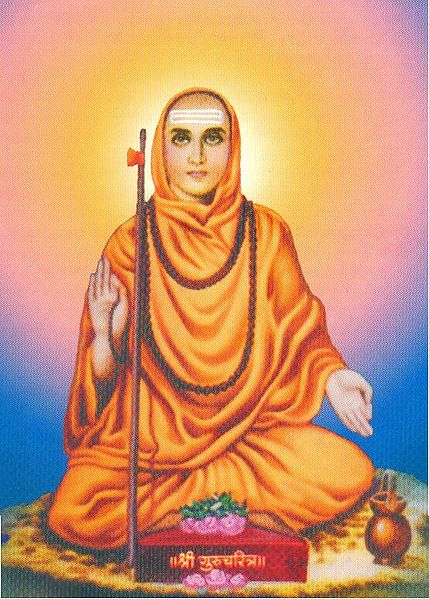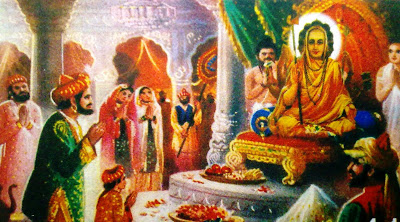Shri Narasimha Saraswati नरसिहसरस्वती incarnation
Shri Narasimha Saraswati (Nrusimha Saraswati) is considered the second avatar of Shri Dattatreya. The only way we know about his life is through the remarkable and most influential book in Marathi literature, Shri GuruCharitra written by Shri Saraswati Gangadhar, one of the most talented poet and philosopher ever known in Marathi literature in Maharashtra.
Shri Narasimha Saraswati (henceforth referred in the article as Shri Guru) is considered as the incarnation of Shri Shripad Shri Vallabha who lived in Kuravpur. Shri Narasimha Saraswati is considered as the Guru by the Datta-Sampradaya people. His life story as given in Shri GuruCharitra is read and followed by hundreds of thousands of devotees. Shri Saibaba is also considered in this lineage of the Swamis or Gurus.
His name is Narahari or Shalgramdev that was kept at the beginning. His father's name is Madhav and mother's name is Amba-Bhavani. They lived at Karanjapur which is modern Lad-Karanja in Maharashtra. His surname is Kale.He was born in Deshastha Brahmin family. At Lad-Karanja there is the original house where he was born. Although the house is no longer in the original shape, but still some parts remain and have been converted in to a temple.
The study of his life and life events have put his time to be from 1378AD to 1458AD when he took Samadhi in Kardali-van (Jungle of Kardali trees). The only documented source of his life is Shri GuruCharitra. The writer of this book did not have direct contact with Shri Guru, but possibly had the original Sanskrit version of the Guru-charitra in front of him written by one of the four disciples of Shri Guru. The disciple is Shri Siddha. The whole book is written as a conversation between a disciple Namdharak and Siddha.
His Guru Tradition (Guru-Parampara)
Shri Narasimha Saraswati comes from the tradition of Shringeri Math. Jagatguru Shri Adi Shankaracharya also comes from this same tradition. The guru-lineage is as follows: Shankar - Vishnu - Bramha - Vasishtha - Parashar - Vyas - Shuka - Gaudpadacharya - Govindacharya - Shankaracharya - Vishwarupacharya - Nityabodhghanacharya - Dnyanaghanacharya - Dnyanamottamacharya - Dnyanagiri - Simhagiri - Ishwartirtha - Narasimhatirtha - Vidyatirtha - Vidyaranya - Vidyatirthasaraswati - Malayanandasaraswati - Devatirtha Saraswati - Yadavendra Saraswati - Krishna Saraswati -Narasimha Saraswati.

Shri GuruCharitra
In Shri GuruCharitra Chapter 11 onwards is the description of life story of Shri Narasimha Saraswati. After he was born the first words he said were OM which are considered very holy. However, until he was 7 he did not utter any other word other than OM, so his parents were worried about his speech ability. However, he showed by hand gestures that after his Upanayana (Munja) he will be able to speak. In fact after his munja was performed he was able to speak all the vedas and even started delivering lectures on it. This was remarkable for a 7 year old kid and many senior learned Brahmins in the village started coming to him for learning! He left home and went for Kashi-pilgrimage and took Sannyasa at Kashi from Shri Krishna Saraswati. The second part of his name comes from this guru, who eventually named him Shri Narasimha Saraswati. This is a Sanskrit name. Now he became the Guru. After visiting several holy places he returned back to Karanja, met his parents. He was possibly of age 30years that time. After that he further visited various places and finally settled in Ganagapur (now in State Karnataka) for the last few decades of his life. All of this is reported in Shri GuruCharitra.
Sultan of Bedar
